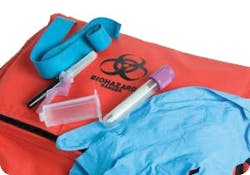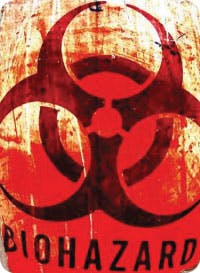Address deficiencies in bloodborne pathogens exposure management
The Occupational Safety and Health
Administration’s (OSHA’s) inspection history for a particular industry
aids in gaining insight into the industry’s performance in managing
safety and health. In clinical laboratories, looking at the most-cited
OSHA violations teaches some important lessons. Safety managers can
reduce the risk of needle sticks and bloodborne pathogens exposure to
their workers by strengthening areas identified as weak points at other
clinical laboratories inspected by OSHA.
OSHA inspection history
During the last two fiscal years, Federal OSHA
inspections in clinical laboratories have uncovered more violations of
the agency’s bloodborne pathogens (BBP) standard than for all other OSHA
standards combined.* While clinical laboratories received citations for
compliance deficiencies with other OSHA standards, more than 80% of the
violations cited by Federal OSHA was related to laboratories failing to
adhere to provisions of the BBP standard, 29 CFR 1910.1030.
Among the bloodborne-related deficiencies most
commonly encountered by OSHA, clinical laboratories often failed to:
- update the facility’s Exposure Control Plan (ECP) at least annually
[29 CFR 1910.1030(c)(1)(iv)]; - outline a detailed written plan for compliance with the BBP standard
[29 CFR 1910.1030(c)(1)(ii)(B)]; - affix warning labels to regulated waste containers, refrigerators,
freezers, or other containers of blood or other potentially infectious
materials [29 CFR1910.1030(g)(1)(i)(A)]; - ensure that all employees with occupational exposure participate in
a training program at no cost to the employee [29 CFR 1910.1030(g)(2)(i)];
and - solicit input in the identification, evaluation, and selection of
effective engineering and work practice controls from non-managerial
employees who are potentially exposed to injuries from contaminated
sharps [29 CFR 1910.1030(c)(1)(v)].
The management of bloodborne pathogens exposure requires a team
effort.
Other deficiencies encountered were in the
facilities’ written ECP and in the implementation and use of sharps with
engineered sharps safety devices, or SESIPs.
These commonly identified shortcomings can increase
the chances that employees will experience needle sticks or other sharps
injuries that could expose them to bloodborne pathogens. Managers can use
this information when reviewing areas within their own facilities that may
be in need of improvement.
What can managers do?
The management of bloodborne pathogens exposure
requires a team effort. Using a team approach to bloodborne exposure
management can help facilities avoid some of the major deficiencies detected
during OSHA inspections of clinical laboratories. As a first step to
employee safety in any laboratory, managers and facility administrators must
recognize that achieving this goal requires active, ongoing involvement on
their part as well as on the part of employees.
Employee compliance is essential to employee protection.
Managers must also be vigilant about ensuring that
employees are trained and fully informed of all BBP program aspects
established for their protection. Ensuring that proper warning labels are
affixed to refrigerators, freezers, and other containers is one way of
informing employees and preparing them to do their part in taking
appropriate precautions to protect themselves from exposure incidents.
Employee training
Formal and informal employee training should also be
developed and be performed frequently. As the OSHA inspection history
indicates, many facilities fall short in this area as well. Initial employee
training goes a long way in garnering employee adherence to established safe
practices and procedures. It is important to also keep in mind that employee
training requires ongoing and active updates. The OSHA standard requires
that employee training be repeated at least annually, but employers must
also conduct more frequent updates whenever new procedures or devices are
introduced to staff.
Employee buy in
Employee involvement is an essential element of the
team effort needed to prevent bloodborne pathogens exposure incidents. The
OSHA BBP standard calls for managers to solicit input from non-managerial
employees covered by the standard when identifying, evaluating, and
selecting effective engineering and work practice controls. There are clear
benefits to having employees buy in on the devices and work practices they
must use prior to implementing them.
One benefit is that employees are more familiar with
the day-to-day operations and may offer valuable suggestions on how their
tasks can be performed more safely and efficiently. Another benefit is that
employees might be more likely to follow the procedures and use devices that
they help select. Employee compliance is essential to employee protection.
Dionne Williams, MPH, is a senior
Industrial Hygienist in the Office of Health Enforcement in OSHA’s
Directorate of Enforcement Programs in Washington, DC.
* Fiscal years range from 10/1/07-9/30/08 and
10/1/08-5/31/09.
OSHA compliance assistance options
OSHA offers tools employers can use to improve
safety and health management. OSHA booklet: Model Plans and Programs for
the OSHA Bloodborne Pathogens and Hazard Communications Standards (OSHA
3186 – 2003) provides employers with a sample written ECP from which the
facility can model its own site-specific written ECP. The publication
can be located on OSHA’s site at
https://www.osha.gov/pls/publications/publication.searchResults?pSearch=bloodborne.
Other bloodborne pathogens-related information
can be accessed on OSHA’s bloodborne safety and health topics page at
www.osha.gov/SLTC/bloodbornepathogens/index.html.
Additionally, OSHA has a healthcare quickstart
webpage that can be used to guide facilities in putting together the
components of a safety and health management program:
https://www.osha.gov/dcsp/compliance_assistance/quickstarts/health_care/index_hc.html.



